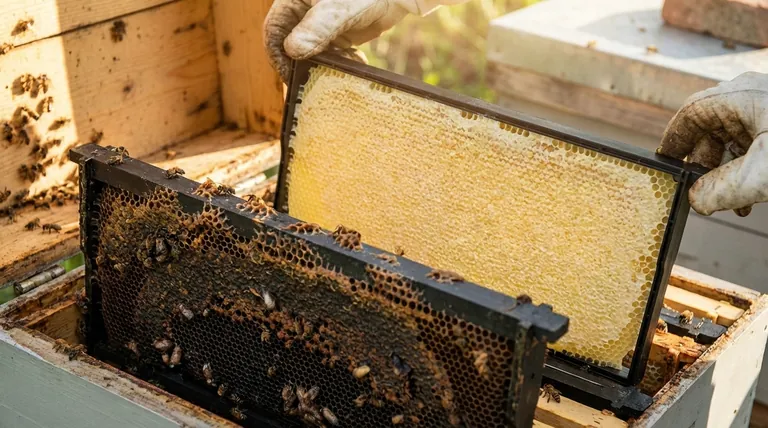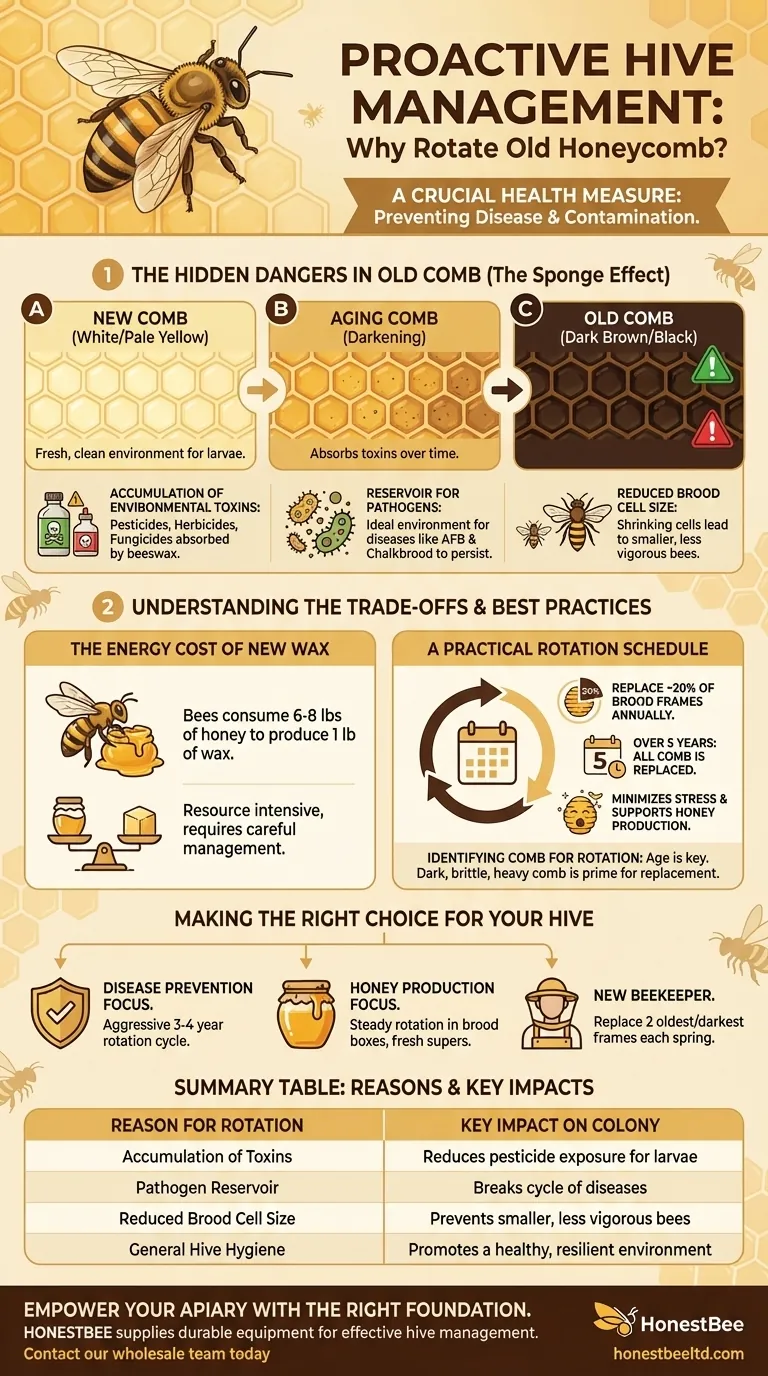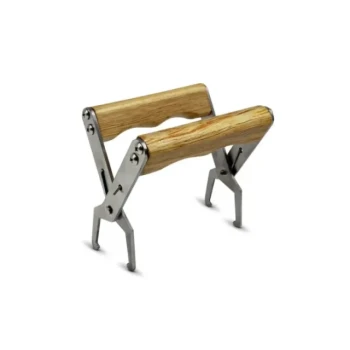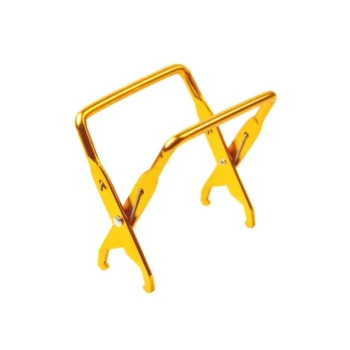In beekeeping, proactive hive management is paramount. Beekeepers choose to rotate out old honeycomb primarily as a crucial health measure for the colony. Over time, beeswax acts like a sponge, absorbing environmental toxins, pesticides, and harboring pathogens, which can lead to poor colony health and the outbreak of disease.
The core principle is simple: rotating old comb is not just about cleanliness. It is a fundamental disease prevention strategy that breaks the cycle of contamination and ensures a healthy, vigorous environment for raising new generations of bees.

The Hidden Dangers in Old Comb
Old comb, especially in the brood nest where bees are raised, can become a significant liability to a colony's health. The porous nature of beeswax makes it susceptible to accumulating harmful substances over several years.
The Accumulation of Environmental Toxins
Beeswax is lipophilic, meaning it readily absorbs fat-soluble substances. This includes pesticides, herbicides, and fungicides that foraging bees inevitably bring back to the hive on their bodies.
These chemicals build up in the wax over time, creating a toxic environment for developing larvae and potentially impacting the long-term health and vitality of the entire colony.
A Reservoir for Pathogens
Old comb provides an ideal environment for pests and pathogens to persist. The spores of serious diseases, such as American Foulbrood (AFB) and Chalkbrood, can remain viable in old comb for years.
By leaving contaminated comb in the hive, the beekeeper allows these diseases a permanent reservoir from which they can re-infect the colony, especially during periods of stress.
Reduced Brood Cell Size
Each time a new bee is raised in a cell, it leaves behind a thin silken cocoon. Over dozens of generations, this accumulation of cocoons, along with propolis and other materials, gradually reduces the interior volume of the cell.
This shrinking can result in smaller, potentially less vigorous adult bees being raised, which can subtly weaken the colony's workforce over time.
Understanding the Trade-offs and Best Practices
While comb rotation is essential, it requires an investment of resources from both the beekeeper and the bees. Understanding the process helps in managing it effectively.
The Energy Cost of New Wax
Producing beeswax is an energy-intensive process for honey bees. It is estimated that bees must consume 6 to 8 pounds of honey to produce just one pound of wax.
Forcing bees to constantly draw new comb can divert resources away from honey storage. This is why rotation is done methodically, not all at once.
Identifying Comb for Rotation
Age is the primary indicator. New comb is typically white or pale yellow. As it is used for brood rearing, it will darken through shades of yellow, tan, and brown.
Comb that is dark brown or black, with thick, brittle cell walls, is a prime candidate for rotation. It has likely been in use for several years.
A Practical Rotation Schedule
A common and sustainable strategy is to replace approximately 20% of the frames in the brood chamber each year. This means that over a five-year period, all the comb in the hive will have been replaced.
This gradual approach minimizes stress on the colony, allowing them to draw out new comb during a strong nectar flow without significantly impacting honey production.
Making the Right Choice for Your Hive
Applying a consistent comb rotation strategy is one of the most effective actions a beekeeper can take to ensure long-term colony health.
- If your primary focus is disease prevention: Make an aggressive comb rotation (e.g., a 3-4 year cycle) a non-negotiable part of your annual hive management plan.
- If your primary focus is maximizing honey production: Maintain a steady rotation in the brood boxes to keep the colony's "engine" strong, while ensuring the honey supers always have fresh, clean comb.
- If you are a new beekeeper: Start with the simple goal of replacing the two oldest, darkest frames in each brood box every spring.
By treating comb rotation as a fundamental aspect of hive hygiene, you empower your bees to build a resilient and thriving colony.
Summary Table:
| Reason for Rotation | Key Impact on Colony |
|---|---|
| Accumulation of Toxins | Reduces pesticide/herbicide exposure for larvae |
| Pathogen Reservoir | Breaks cycle of diseases like American Foulbrood |
| Reduced Brood Cell Size | Prevents smaller, less vigorous bees from emerging |
| General Hive Hygiene | Promotes a healthy, resilient environment for growth |
Empower your apiary with the right foundation. Proactive comb rotation is a cornerstone of successful beekeeping. For commercial apiaries and distributors, having a reliable supply of high-quality equipment is just as critical. HONESTBEE supplies the durable beekeeping supplies and equipment you need to implement effective hive management strategies at scale. Let us help you build stronger, healthier colonies. Contact our wholesale team today to discuss your equipment needs.
Visual Guide

Related Products
- Plastic Bee Frame Beekeeping Hive Frames for Wholesale
- Manual Beeswax Comb Foundation Machine Wax Foundation Mill Embossing Machine
- Food Grade Plastic bee Foundation for Bee Frames
- HONESTBEE Wired and Assembled Wooden Bee Frames Foundation for a Thriving Hive
- Colorful Silicone Beeswax Foundation Mold Mould for Beekeeping
People Also Ask
- Can you boil plastic bee frames? Avoid This Costly Mistake and Protect Your Hive
- Can beekeepers switch between wooden and plastic frames? Optimize Your Hive's Performance
- What is the role of oxalic acid in plants? A Key to Plant Defense and Internal Regulation
- What are the advantages of plastic frames for beehives? Boost Apiary Efficiency & Durability
- What is a general rule for beekeepers with many hives regarding frame choice? Maximize Efficiency with Plastic Frames



















